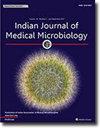中国成都 B 群链球菌的临床感染特征和耐药性。
IF 1.4
4区 医学
Q4 IMMUNOLOGY
引用次数: 0
摘要
目的调查2019年至2021年中国成都地区B群链球菌(无乳链球菌,GBS)的临床感染特征和抗生素耐药性,并为临床合理用药提供数据支持:这是一项回顾性研究,收集了2019年1月至2021年12月在中国成都分离的203株培养阳性GBS菌株,所有菌株均由VITEK 2 Compact全自动微生物细菌鉴定仪鉴定。数据使用 WHONET 5.6 软件得出。对样本类型和病房分布进行了统计。从原始数据中筛选出孕妇和新生儿,并分别计算其妊娠结局:GBS菌株主要集中在产科和新生儿科,分别占40.9%和33.5%。标本类型主要为阴道分泌物、羊水和痰液,分别占 25.6%、26.1% 和 18.7%。绒毛膜羊膜炎、胎膜早破和早产主要发生在感染后的孕妇身上,分别占 44.4%、31.5% 和 24.1%。新生儿则主要被诊断为新生儿肺炎、新生儿败血症、呼吸衰竭和化脓性脑膜炎,分别占所有阳性新生儿的 91.8%、61.2%、44.9% 和 16.3%。2019-2021年对840名孕妇进行了GBS定植筛查,共发现108名GBS阳性孕妇,GBS定植率为12.9%。108 名 GBS 阳性孕妇中共有 9 名新生儿出现早发性疾病。新生儿的发病率为 8.3%。没有发现对青霉素和氨苄西林耐药的菌株,而对四环素和林可霉素的耐药率高于50%,分别为60.1%和53.2%:结论:GBS 感染主要影响成都地区的孕妇和新生儿,可导致不良的母婴结局。应注意加强对围产期泌尿生殖道分泌物中 GBS 的普遍筛查和 IAP(产前抗生素预防)预防策略。应使用适当的抗生素进行抗菌治疗。青霉素仍是治疗 GBS 的一线药物。这些举措对于减少母婴传播和新生儿感染非常重要。本文章由计算机程序翻译,如有差异,请以英文原文为准。
Characterization of clinical infection and drug resistance of group B streptococcus in Chengdu, China
Objective
To investigate the clinical infection characteristics and antibiotic resistance of Group B Streptococcus (Streptococcus agalactiae, GBS) in Chengdu, China, from 2019 to 2021, as well as to provide data to support rational clinical drug use.
Methods
This was a retrospective study to collect 203 culture-positive GBS strains isolated from January 2019 to December 2021 in Chengdu, China, all of which were identified by the VITEK 2 Compact automated microbial Bacterial identification instrument. Data were derived using WHONET 5.6 software. The sample type and ward distribution were counted. Pregnant women and newborns were screened from the original data and their pregnancy outcomes were calculated respectively.
Results
GBS strains were mainly concentrated in obstetrics and neonatology departments, accounting for 40.9 % and 33.5 %. The types of specimens were mainly vaginal secretions, amniotic fluid and sputum, accounting for 25.6 %, 26.1 % and 18.7 %, respectively. Chorioamnionitis, premature rupture of membranes and preterm delivery occurred mainly in pregnant women after infection, accounting for 44.4 %, 31.5 % and 24.1 %. Neonates, on the other hand, were mainly diagnosed with neonatal pneumonia, neonatal sepsis, respiratory failure and septic meningitis, accounting for 91.8 %, 61.2 %, 44.9 % and 16.3 % of all positive neonates. 840 pregnant women were screened for GBS colonization from 2019 to 2021, and a total of 108 GBS positive pregnant women were identified, with a GBS colonization rate of 12.9 %. A total of 9 neonates from 108 GBS positive pregnant women developed early-onset disease. The morbidity in neonates was 8.3 %. No strains resistant to penicillin and ampicillin were found, while the resistance rates of tetracycline and clindamycin were higher than 50 %, respectively 60.1 % and 53.2 %.
Conclusion
GBS infection mainly affected pregnant women and newborns in Chengdu, China, which can lead to adverse maternal and infant outcomes. Attention should be paid to strengthening general screening of GBS in perinatal urogenital secretions and the prevention strategy of IAP (intrapartum antibiotic prophylaxis). Antimicrobial therapy should be administered with appropriate antibiotics. Penicillin was still the first line drug for the treatment of GBS. These initiatives were important to reduce mother-to-child transmission and neonatal infections.
求助全文
通过发布文献求助,成功后即可免费获取论文全文。
去求助
来源期刊

Indian Journal of Medical Microbiology
IMMUNOLOGY-
CiteScore
2.20
自引率
0.00%
发文量
154
审稿时长
73 days
期刊介绍:
Manuscripts of high standard in the form of original research, multicentric studies, meta analysis, are accepted. Current reports can be submitted as brief communications. Case reports must include review of current literature, clinical details, outcome and follow up. Letters to the editor must be a comment on or pertain to a manuscript already published in the IJMM or in relation to preliminary communication of a larger study.
Review articles, Special Articles or Guest Editorials are accepted on invitation.
 求助内容:
求助内容: 应助结果提醒方式:
应助结果提醒方式:


